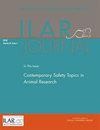提高临床前研究的可重复性、再现性和可靠性:共同的责任
IF 3.1
3区 农林科学
Q1 VETERINARY SCIENCES
引用次数: 2
摘要
可重复和可靠的科学调查依赖于识别和考虑可能影响所使用的模型系统的各种内在和外在因素。这些因素的影响必须在研究的所有阶段进行管理:计划、执行和报告。在过去的十年中,体内(动物)研究的价值受到越来越多的审查,因为有多份报告记录了对人类研究的不良可翻译性。这些失败归因于各种原因,包括糟糕的研究设计和执行以及报告的不足。重要的是要认识到,实现可重复和可靠的临床前研究结果是一项共同的责任,需要调查团队和动物护理和使用项目人员之间的伙伴关系。无数的内在因素,如物种、品系/亚品系、年龄、性别、生理和健康状况,以及外在因素,包括温度、湿度、光照、饲养系统和饮食,都需要在研究计划和执行过程中得到认识和管理,因为它们会影响动物的生理和生物反应。同样重要的是需要记录和报告这些细节。ARRIVE和PREPARE指南是由有关科学家、兽医、统计学家、期刊编辑和资助机构制定的,目的是协助调查小组和科学期刊管理和报告内在和外在因素,以提高可重复性和可靠性。这一期的ILAR杂志将重点关注已经被认为会混淆动物研究的各种外在因素。本文章由计算机程序翻译,如有差异,请以英文原文为准。
Improving Replicability, Reproducibility, And Reliability In Preclinical Research: A Shared Responsibility
Abstract
Reproducible and reliable scientific investigation depends on the identification and consideration of various intrinsic and extrinsic factors that may affect the model system used. The impact of these factors must be managed during all phases of a study: planning, execution, and reporting. The value of in vivo (animal) research has come under increasing scrutiny over the past decade because of multiple reports documenting poor translatability to human studies. These failures have been attributed to various causes, including poor study design and execution as well as deficiencies in reporting. It is important to recognize that achieving reproducible and reliable preclinical research results is a joint responsibility that requires a partnership between the investigative team and the animal care and use program staff. The myriad of intrinsic factors, such as species, strain/substrain, age, sex, physiologic and health status, and extrinsic factors, including temperature, humidity, lighting, housing system, and diet, need to be recognized and managed during study planning and execution, as they can influence animal physiology and biological response. Of equal importance is the need to document and report these details. The ARRIVE and PREPARE guidelines were developed by concerned scientists, veterinarians, statisticians, journal editors, and funding agencies to assist investigative teams and scientific journals manage and report on intrinsic and extrinsic factors to improve reproducibility and reliability. This issue of the ILAR Journal will focus on the various extrinsic factors that have been recognized to confound animal research.
求助全文
通过发布文献求助,成功后即可免费获取论文全文。
去求助
来源期刊

Ilar Journal
农林科学-兽医学
CiteScore
5.10
自引率
20.00%
发文量
8
审稿时长
>18 weeks
期刊介绍:
The ILAR Journal is the peer-reviewed, theme-oriented publication of the Institute for Laboratory Animal Research (ILAR), which provides timely information for all who study, use, care for, and oversee the use of animals in research. The journal publishes original articles that review research on animals either as direct subjects or as surrogates for humans. According to policy, any previously unpublished animal research reported in the ILAR Journal will have been conducted according to the scientific, technical, and humanely appropriate guidelines current at the time the research was conducted in accordance with the Guide for the Care and Use of Laboratory Animals or other guidance provided by taxonomically-oriented professional societies (e.g., American Society of Mammalogy) as referenced in the Guide.
 求助内容:
求助内容: 应助结果提醒方式:
应助结果提醒方式:


